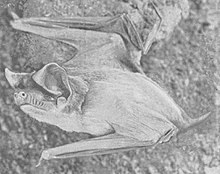Trevor's free-tailed bat
| Trevor's free-tailed bat | |
|---|---|

| |
| Scientific classification | |
| Domain: | Eukaryota |
| Kingdom: | Animalia |
| Phylum: | Chordata |
| Class: | Mammalia |
| Order: | Chiroptera |
| Family: | Molossidae |
| Genus: | Mops |
| Species: | M. trevori
|
| Binomial name | |
| Mops trevori J.A. Allen, 1917
| |
| Synonyms | |
| |
The Trevor's free-tailed bat (Mops trevori) is a species of bat in the family Molossidae. It is found in Central African Republic, Democratic Republic of the Congo, Ivory Coast, Ghana, Guinea, Nigeria, South Sudan, and Uganda. Its natural habitats are subtropical or tropical dry forests and moist savanna. It is threatened by habitat loss.
Taxonomy and etymology
It was described as a new species in 1917 by American zoologist Joel Asaph Allen. The holotype had been collected by James Chapin in Faradje.[2] The eponym for the species name "trevori" was John Bond Trevor. Trevor was a trustee of the American Museum of Natural History, which employed Allen, as well as Chairman of the Committee on African Exploration.[3]
Description
Its forearm length is 51–55 mm (2.0–2.2 in). Its flight membranes are dark brown and its fur is sepia brown, yellowish-brown, or a pale, rusty brown.[4]
Range and habitat
Its range includes part of Central and West Africa. It has been documented in Central African Republic, Democratic Republic of the Congo, Ivory Coast, Ghana, Guinea, Nigeria, South Sudan, and Uganda.[1]
Conservation
As of 2019, it is evaluated as a data deficient species by the IUCN. It meets the criteria for this designation because there have been few records of it, though its range is large. Overall, little is known about its biology and ecology. Its population is believed to be decreasing.[1]
References
- ^ a b c Mickleburgh, S.; Hutson, A.M.; Bergmans, W.; Cotterill, F.P.D.; Fahr, J. (2019). "Mops trevori". IUCN Red List of Threatened Species. 2019: e.T13850A22077590. doi:10.2305/IUCN.UK.2019-2.RLTS.T13850A22077590.en.
- ^ Allen, J.A (1917). "The American Museum Congo Expedition collection of bats". Bulletin of the AMNH. 37: 555.
- ^ Beolens, B.; Watkins, M.; Grayson, M. (2009). The eponym dictionary of mammals. JHU Press. p. 417. ISBN 9780801895333.
- ^ Van Cakenberghe, Victor; Gembu Tungaluna, Guy-Crispin; Musaba Akawa, Prescott; Seamark, Ernest; Verheyen, Erik (2017). "The bats of the Congo and of Rwanda and Burundi revisited (Mammalia: Chiroptera)". European Journal of Taxonomy (382). doi:10.5852/ejt.2017.382.

